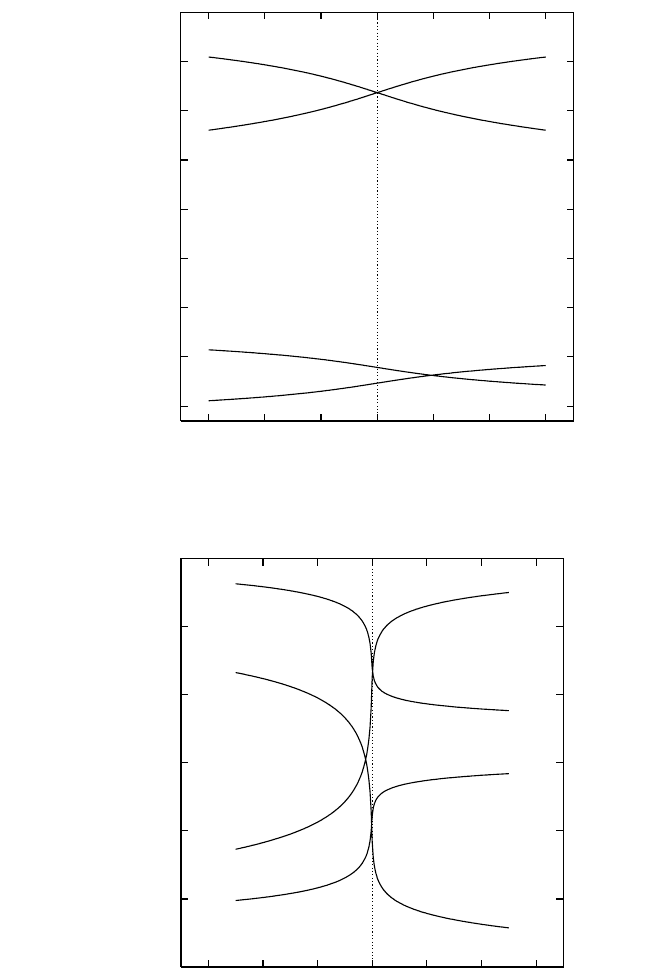Gupta D. (Ed.). Diffusion Processes in Advanced Technological Materials
Подождите немного. Документ загружается.


132 DIFFUSION PROCESSES IN ADVANCED TECHNOLOGICAL MATERIALS
One of the complexes usually dominates all others, although this leading
complex may change with temperature and/or pressure. Dealing with
composition-conserving complexes means making a judicious choice of
the defect reactions. The reactions should conserve the chemical composi-
tion and describe the creation (annihilation) of the chosen defect com-
plexes. For example, the three reactions can be chosen as the divacancy
(Dv) formation:
V
a
V
b
∆ 0, (27)
the exchange defect (Ex) formation:
B
a
A
b
∆ 0, (28)
and the triple-defect formation on the a sublattice (TA),
2V
a
A
b
∆ 0. (29)
In these reactions, 0 denotes the ground state of the compound (perfect lat-
tice). The free energies of these reactions represent the formation free
energies of the respective defect complexes (Dv, Ex and TA). The free
energy of each complex is found by combining the formation free ener-
gies of individual defects, each obtained by a separate calculation, accord-
ing to the formula of the reaction. For example, the free energy of an
exchange defect equals g
Ex
g
f
A
b
g
f
B
a
. Similar rules apply to energies
and entropies of defect complexes. Thus, the energy of a triple defect, TA,
equals e
TA
2e
f
V
a
e
f
A
b
. Remember that the formation energy and entropy
of an individual defect are defined here under the condition of a constant
number of atoms.
As an illustration of such calculations, Table 3.1 presents the formation
energies and entropies of several defect complexes in the intermetallic
compounds TiAl and NiAl.
[6, 81]
The crystal structures of these compounds
are L1
0
(CuAu prototype) and B2 (CsCl prototype), respectively. These
compounds demonstrate two different mechanisms of non-stoichiometry
that are discussed next. They also represent promising structural materials
for advanced high-temperature applications, particularly in the aerospace
industry.
[82, 83]
The entropies listed in Table 3.1 were computed in the clas-
sical harmonic approximation. Figure 3.3 shows the calculated composi-
tion dependencies of the point defect concentrations in these compounds
(number of defects per lattice site). We observe that TiAl is strongly dom-
inated by antisites Ti
Al
and Al
Ti
for all compositions, whereas the vacancy
concentrations are relatively small. In contrast, in the NiAl compound, the
antisites Ni
Al
and vacancies V
Ni
are the dominant defects; other defect
Ch_03.qxd 11/29/04 6:08 PM Page 132

ATOMISTIC COMPUTER SIMULATION OF DIFFUSION, MISHIN 133
concentrations are orders of magnitude smaller. These observations are in
agreement with previous calculations performed by neglecting defect
entropies but using first-principles defect energies.
[39, 84]
Constitutional point defects in compounds are an important concept.
At low temperatures, a deviation of the chemical composition from the
stoichiometry is accommodated by a certain type of point defect, which is
called constitutional. Constitutional defects are conceptually different
from thermal defects. The latter are thermally excited and only exist at
elevated temperatures due to the configurational entropy of the com-
pound. In contrast, constitutional defects exist at any temperature and
serve to maintain the particular off-stoichiometric composition of the
compound. If we gradually decrease the temperature at a fixed composi-
tion, the concentrations of all thermal defects will go to zero, while the
concentration of constitutional defects will remain constant and will only
depend on the composition. In other words, constitutional defects are what
is left when all thermal defects freeze out. Clearly, constitutional defects
only exist in off-stoichiometric compositions. Importantly, the type of
constitutional defect can be different in different compounds, and in each
compound can be different on either side of the stoichiometry.
For example, in TiAl, the off-stoichiometry is accommodated by Ti
Al
antisites on the Ti-rich side and Al
Ti
antisites on the Al-rich side. Thus, the
antisites are the constitutional defects. The antisites are also the dominant
thermal defects in this compound [Fig. 3.3(a)]. Both facts have one common
origin: the exchange defect Ti
Al
Al
Ti
is the most favorable composition-
conserving defect complex in TiAl (Table 3.1). This explains why antisites
are excited most easily by thermal fluctuations and are readily available
to accommodate the off-stoichiometry. Such compounds are classified as
antisite-disorder type.
Table 3.1. Energies and Entropies of Composition-Conserving Point Defect
Complexes in the Intermetallic Compounds TiAl
[81]
and NiAl
[6]
Calculated
with Embedded-atom Potentials. Defect Complexes: Ex, Exchange Defect;
Dv, Divacancy; TA, Triple Defect on the a Sublattice; TB, Triple Defect on
the b Sublattice.
TiAl NiAl
Notation Complex Energy (eV) Entropy (k
B
) Energy (eV) Entropy (k
B
)
Ex A
b
B
a
0.765 1.420 2.765 4.903
Dv V
a
V
b
3.168 2.804 2.396 2.965
TA 2V
a
A
b
3.525 3.952 2.281 3.588
TB 2V
b
B
a
3.576 3.075 5.276 7.245
Ch_03.qxd 11/29/04 6:08 PM Page 133

134
10
-8
10
-7
10
-6
10
-5
10
-4
10
-3
10
-2
10
-1
10
0
44 46 48 50 52 54 56
at.% Ti
Defect concentration
V
Ti
V
Al
Al
Ti
Ti
Al
Defect concentration
V
Ti
V
Al
Al
Ti
Ti
Al
10
-12
10
-10
10
-8
10
-6
10
-4
10
-2
10
0
44 46 48 50 52 54 56
at.% Ni
Defect concentration
V
Ni
Al
Ni
Ni
Al
V
Al
Al
Ni
V
Ni
Ni
Al
V
Al
Defect concentration
V
Ni
Al
Ni
Ni
Al
V
Al
Al
Ni
V
Ni
Ni
Al
V
Al
Defect concentration
V
Ni
Al
Ni
Ni
Al
V
Al
Al
Ni
V
Ni
Ni
Al
V
Al
Defect concentration
V
Ni
Al
Ni
Ni
Al
V
Al
Al
Ni
V
Ni
Ni
Al
V
Al
Defect concentration
V
Ni
Al
Ni
Ni
Al
V
Al
Al
Ni
V
Ni
Ni
Al
V
Al
(a) TiAl
(b) NiAl
Figure 3.3 Equilibrium point-defect concentrations in TiAl
[81]
and NiAl
[6]
at 1000 K.
These plots illustrate two different mechanisms of atomic disorder in compounds:
the antisite mechanism (TiAl) and the triple-defect mechanism (NiAl).
Ch_03.qxd 11/29/04 6:08 PM Page 134

ATOMISTIC COMPUTER SIMULATION OF DIFFUSION, MISHIN 135
In contrast, in NiAl, it is the triple defect 2V
Ni
Ni
Al
that is the most
favorable defect complex (Table 3.1). This makes V
Ni
vacancies and Ni
Al
antisites the dominant thermal defects [Fig. 3.3(b)]. Furthermore, being
most easily available, these defects also serve as constitutional defects,
with Ni
Al
antisites appearing on the Ni-rich side and V
Ni
vacancies appear-
ing on the Al-rich side. The existence of constitutional Ni vacancies in
Al-rich NiAl was confirmed experimentally.
[85]
Intermetallic compounds
with this mechanism of disorder are called triple-defect type. Besides
NiAl, they are represented by the B2 compounds CoAl and CoGa.
To further demonstrate the convenience of the defect-complex
approach, we will derive approximate expressions for point defect con-
centrations in stoichiometric TiAl and NiAl. For the antisite-disorder
compound TiAl, in a first approximation we can neglect the vacancies and
consider antisite defects only. Then, the concentrations of both antisites
are equal. The mass action law for the exchange defect reaction (28),
c
Ti
Al
c
Al
Ti
exp
, (30)
immediately gives us
c
Ti
Al
c
Al
Ti
exp
. (31)
At the next step, we write the mass action law for the triple-defect
reaction (29),
c
2
V
Ti
c
Ti
Al
exp
.
Substituting c
Ti
Al
from Eq. (31), we obtain the Ti vacancy concentration:
c
V
Ti
exp
. (32)
By simply swapping the species in this equation, we immediately obtain
the Al vacancy concentration:
c
V
Al
exp
, (33)
2g
TB
g
Ex
4k
B
T
2g
TA
g
Ex
4k
B
T
g
TA
k
B
T
g
Ex
2k
B
T
g
Ex
k
B
T
Ch_03.qxd 11/29/04 6:08 PM Page 135

136 DIFFUSION PROCESSES IN ADVANCED TECHNOLOGICAL MATERIALS
where, g
TB
is the free energy of the triple defect TB 2V
Al
Al
Ti
on the
Al sublattice. Using the obvious relation g
TA
g
TB
2g
Dv
g
Ex
, we can
rewrite Eq. (33) in a different form:
c
V
Al
exp
. (34)
These equations allow us to calculate all four defect concentrations given
three complex free energies: g
Dv
, g
Ex
and g
TA
.
Turning to NiAl, we proceed along similar lines. We first consider the
dominant defect reaction, Eq. (29), and neglect the concentrations of V
Al
and Al
Ni
. Then, we have c
V
Ni
2c
Ni
Al
, and the mass action law,
c
2
V
Ni
c
Ni
Al
exp
, (35)
gives us
c
V
Ni
2
13
exp
(36)
and
c
Ni
Al
2
23
exp
. (37)
Knowing the major defect concentrations, we determine the minor ones.
From the divacancy reaction, Eq. (27), we easily obtain:
c
V
Al
2
13
exp
. (38)
Similarly, the exchange reaction, Eq. (28), gives us
c
Al
Ni
2
23
exp
. (39)
3g
Ex
g
TA
3k
B
T
3g
Dv
g
TA
3k
B
T
g
TA
3k
B
T
g
TA
3k
B
T
g
TA
k
B
T
4g
Dv
g
Ex
2g
TA
4k
B
T
Ch_03.qxd 11/29/04 6:08 PM Page 136

ATOMISTIC COMPUTER SIMULATION OF DIFFUSION, MISHIN 137
Again, the four defect concentrations are expressed through three
complex free energies g
Dv
, g
Ex
, and g
TA
. Remember that all defect concen-
trations in Eqs. (30) through (39) are measured relative to the respective
sublattices. They should be divided by a factor of two to obtain the con-
centrations relative to the total number of lattice sites.
The approximate solutions that we have derived predict the defect con-
centrations in the form of the Arrhenius relation. This allows us to define so-
called effective formation energies of individual defects as the respective
exponents. For example, Eq. (36) shows that the effective formation energy
of Ni vacancies in stoichiometric NiAl equals e
TA
3. Although the exact solu-
tions of the problem cannot be expressed in a closed form, effective forma-
tion energies of defects can still be derived by fitting the numerical solutions
to the Arrhenius Law in a reasonable temperature range. Since the Arrhenius
Law is not followed exactly, the result may depend on the chosen tempera-
ture range. Even so, the effective formation energies are useful characteris-
tics that reflect basic trends and facilitate a comparison with experiment.
Many of these considerations apply to ionic solids as well. However,
the charge neutrality requirement imposes a new constraint that has to be
incorporated in the statistical-mechanical models of the defects. Besides
vacancies and antisites, many ionics contain interstitials and (almost
inevitably) impurity atoms, as well as electrons and holes.
3.5.3 Effect of Pressure
Until this point, we neglected the pV term in the Gibbs free energy, p
being the external pressure and V the system volume. If the external pres-
sure is high, this term cannot be neglected, and the free energy of defect
formation, Eq. (25), should be written in a more general form:
g
f
e
f
Ts
f
pV
f
. (40)
Here, V
f
is the defect formation volume, which can be defined as the vol-
ume of a relaxed defected block minus the energy of a perfect lattice block
containing the same number of atoms. Furthermore, the free energy of a
composition-conserving defect complex can be expressed in a form simi-
lar to Eq. (40), with the complex volume given by a linear combination of
the respective defect formation volumes. The linear coefficients are iden-
tical to those for the complex energy and entropy.
[79, 86, 87]
For example, the
free energy of a triple defect TA equals:
g
TA
e
TA
Ts
TA
pV
TA
, (41)
where V
TA
2V
f
V
a
V
f
A
b
.
Ch_03.qxd 11/29/04 6:08 PM Page 137

138 DIFFUSION PROCESSES IN ADVANCED TECHNOLOGICAL MATERIALS
Defect complexes whose formation is accompanied by a larger vol-
ume effect are more susceptible to external pressure. Furthermore, the rel-
ative stability of defect complexes at low temperatures now depends on
their enthalpies g e pV and not just energies. It is, therefore, con-
ceivable that high pressures can alter the type of the most stable defect
complex. This, in turn, would change the types of constitutional defects.
This scenario is especially plausible for NiAl in which all volume effects
are large due to the significant atomic size difference between Ni and
Al.
[86, 88]
It was predicted that high pressures could change the disorder
mechanism in Al-rich NiAl from the triple-defect type to the antisite type,
and that this change would occur as a first-order isostructural phase
transformation.
[86, 88]
The possible transition between the vacancy-disordered
and antisite-disordered phases of NiAl can be represented by a coexis-
tence line on a p-T phase diagram terminating at a critical point.
Equations (24) and (40) are also valid for point defects in elemental
solids, both in the lattice and in the core of extended defects. The way the
external pressure alters the defect concentration depends on the magnitude
and sign of the defect formation volume. Again, high pressures can affect
the relative importance of defects with different formation volumes,
which in turn can reflect on diffusion rates by different mechanisms.
3.6 Transition Rate Calculations
3.6.1 Transition State Theory
Diffusion in solids is mediated by point defect mechanisms. Under
such mechanisms, point defects walk through the solid by random, ther-
mally activated jumps that displace atoms, thus inducing atomic diffusion.
Each defect jump can induce either a single-atom displacement (for exam-
ple, an atom exchanging with a vacancy) or a collective displacement of
two or more atoms (for example, collective mechanisms on the surface
and in grain boundaries). In most cases, point defect jumps fall under the
category of rare events.
[89]
Namely, the atom moved by a defect makes a
huge number of thermal vibrations around its equilibrium position before
making a successful transition to a new state.
It is convenient to discuss this process by considering a dynamic tra-
jectory of the system on the potential energy surface in its configuration
space. The latter has a dimension, M, varying between 3N and 3N 3
(N being the number of atoms in the system), depending on the boundary
conditions. The initial and final states of the system (i.e., the states before
and after the point defect jump) correspond to local minima on the energy
surface. The two states are separated by an (M 1)-dimensional dividing
Ch_03.qxd 11/29/04 6:08 PM Page 138

ATOMISTIC COMPUTER SIMULATION OF DIFFUSION, MISHIN 139
surface that passes along the ridge top between the two energy basins
(Fig. 3.4). We assume that the system follows classical dynamics and is
coupled to a heat bath at a temperature T (canonical ensemble). After
spending a long time wandering within the initial energy basin, the system
eventually accumulates enough thermal energy to reach the dividing sur-
face. Once the dynamic trajectory has crossed the dividing surface, there
is a high probability that it will slide down to the neighboring basin. Once
there, the system will thermalize (establish Boltzmann’s distribution) and
spend a long time in the new state before making another transition back
to the initial or some other state. During the thermalization, the system
forgets how it came to the current state, so that the new jump probabilities
do not depend on the previous jump.
The scenario just described reflects the idea of the transition state the-
ory (TST),
[90]
a powerful tool that enables the calculation of absolute rates,
or rate constants, of thermally activated transitions. The rate constant is
defined as the transition probability per unit time and, in TST, represents
an equilibrium quantity. The critical assumptions of TST are that (1) a
dynamic trajectory crossing the dividing surface inevitably leads to a tran-
sition (i.e., re-crossing events are neglected), and (2) after the transition,
the system has enough time to thermalize before making a next transition.
Other important concepts associated with reaction rate theory are those
of the minimum-energy path (MEP) and the saddle point (Fig. 3.4). The
MEP connects the two energy minima and has the property that the energy
is a minimum in all directions normal to the MEP, but not necessarily along
the MEP. The energy along the MEP reaches a maximum at the saddle
point, which coincides with the intersection of the MEP and the dividing
Saddle point
Dividing surface
(a) Initial Elastic Band
(b) Relaxed Elastic Band
1
1
2
2
MEP
Figure 3.4 Schematic illustration of the nudged-elastic band method. The lines
show contours of potential energy, 1 and 2 are the initial and final states of a
diffusion jump. The circles mark “images” of the elastic band.
Ch_03.qxd 11/29/04 6:08 PM Page 139

140 DIFFUSION PROCESSES IN ADVANCED TECHNOLOGICAL MATERIALS
surface. At the saddle point, one of the eigenvalues of the dynamical matrix
is negative, and the corresponding eigenvector is parallel to the MEP. Thus,
the system at the saddle point has M 1 normal vibration modes. The miss-
ing vibration has converted to a translational degree of freedom associated
with the motion along the reaction path. The importance of the MEPand the
saddle point is that they have the highest statistical weight. Although a par-
ticular dynamic trajectory does not have to coincide exactly with the MEP,
it typically follows it rather closely and crosses the dividing surface near the
saddle point. This makes the saddle point the bottleneck of the transition.
An approximate formulation of TST, called the harmonic TST, is
obtained by applying second order expansions of the potential energy in
the initial state and at the saddle point. Then, the rate constant Γ of the
transition is given by the simple exponential expression:
[91]
Γ n
0
exp
. (42)
Here, e
m
is the energy barrier of the transition, also called the defect
migration energy (hence the superscript m). e
m
equals the saddle-point
energy minus the initial energy. The pre-exponential factor n
0
is called the
attempt frequency; it is expressed through normal vibration frequencies of
the system at the saddle point (n
i
*
) and in the initial state (n
i
):
n
0
.
(43)
This expression originates from the entropy difference between the saddle
point and the initial state evaluated in the harmonic approximation. A
remarkable feature of Eqs. (42) and (43) is that they do not contain any infor-
mation about the final state of the transition. The MEPis not involved either,
except that its direction at the saddle point can be recovered from the eigen-
vector corresponding to the negative eigenvalue of the dynamical matrix.
Equation (42) is the cornerstone of all diffusion rate calculations in
solids. Migration energies of vacancies have been computed for many
elemental solids using either semi-empirical potentials or first-principles
methods. The calculation of n
0
is a slightly more difficult task, but this has
also been done on many occasions. It is finding the saddle point of the
defect jump that becomes the central problem of the rate constant calcu-
lation in many systems.
M
i1
n
i
M1
i1
n
i
*
e
m
k
B
T
Ch_03.qxd 11/29/04 6:08 PM Page 140

ATOMISTIC COMPUTER SIMULATION OF DIFFUSION, MISHIN 141
3.6.2 Finding the Saddle Point
For a vacancy jump in a monoatomic crystal, the saddle point can often
be located from symmetry considerations. However, the required symmetry
is not always available. For example, vacancy jumps in a partially disordered
compound are influenced by other point defects residing next to the jumping
vacancy, so that the MEP does not have a symmetry that allows us to locate
the saddle point. Furthermore, self-interstitial jumps in metals are collective
events in which the two atoms forming a split dumbbell move in a concerted
manner to produce the dumbbell rotation with a simultaneous translation of
the center of mass. This process actually involves three atoms moving simul-
taneously, the third one being the atom forming the new dumbbell. As
another example, GB diffusion demonstrates a rich variety of collective
mechanisms mediated either by vacancies or interstitials.
[92, 93]
In these and
other situations, finding the saddle point becomes a challenging problem.
Early diffusion calculations employed the “drag” method, in which
the atom exchanging with a vacancy was moved between its two equi-
librium positions by small steps and the simulation block was partially
relaxed after each step.
[80, 94–97]
The partial relaxation includes arbitrary
displacements of all atoms except for the jumping atom. The latter is only
allowed to move in directions normal to the jump vector (i.e., vector con-
necting the initial and final states). Since no symmetry is imposed on the
MEP, the latter can readily be a curve connecting the two states. The sad-
dle point is identified as the energy maximum along the curve. This
method has proved to work satisfactorily in many applications, including
diffusion in intermetallic compounds and GBs. Aserious limitation of the
method is that only single-atom jumps can be simulated.
More advanced methods of saddle-point search have recently appeared
in the literature.
[98]
Perhaps the most common and best tested of them is the
nudged elastic band (NEB) method, which was successfully applied to a
variety of rate processes in solids.
[98, 99]
To implement the NEB method, the
initial and final states of the transition must be known. The method starts by
generating a number of replicas, or “images,” of the system. The images ini-
tially represent some arbitrary intermediate configurations between the ini-
tial and final states [Fig. 4.4(a)]. For example, they can be created by a lin-
ear interpolation of atomic coordinates. This set of images is referred to as
an elastic band. The total energy of the elastic band is defined as the sum of
actual potential energies of all images plus the sum of fictitious elastic
deformation energies of imaginary springs connecting neighboring images.
This total energy is minimized with respect to atomic displacements in all
images. To improve the convergence, the elastic band is nudged by modi-
fying some components of atomic and spring forces during the energy min-
imization process. Namely, the atomic forces parallel to the elastic band and
Ch_03.qxd 11/29/04 6:08 PM Page 141
